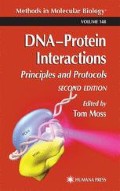Abstract
The interaction of cell-type-specific or inducible transcription factors with regulatory DNA sequences in gene promoters or enhancers is a pivotal step in genetic reprograming during cell proliferation and differentiation and in response to extracellular stimuli. The study of these interactions and the characterization of the factors involved are, therefore, a critical aspect of gene control. Transcription factor-DNA interactions in eukaryotes have been demonstrated by a wide variety of biochemical approaches, including deoxyribonuclease I (DNase I) and chemical nuclease footprinting (1–3) (Chapter 3), methylation protection (4) (Chapter 14), electrophoretic mobility-shift (5,6) (Chapter 2), and Southwestern (SW) assays (7) (Chapter 17). Despite their broad applicability, these techniques provide only partial information about the DNA-protein system under investigation. The first three techniques identify either the site(s) of transcription factor binding within the DNA (size and location of nucleotide stretches or atoms on individual bases) or the complexity of the binding pattern (stoichiometry), but do not yield information about the protein(s) involved. On the other hand, the SW assay reveals the relative molecular mass of renaturable (on a membrane support) active species in heterogeneous protein mixtures facilitating their identification, but fails to localize the exact target element within the probing DNA sequence.
Access this chapter
Tax calculation will be finalised at checkout
Purchases are for personal use only
References
Galas, D. J. and Schmitz, A. (1978) DNase footprinting: A simple method for the detection of protein-DNA binding specificities. Nucleic Acids Res. 5, 3157–3170.
Tullius, T. D. and Dombroski, B. A. (1986) Hydroxyl radical “footprinting”: highresolution information about DNA-protein contacts and application to λ repressor and Cro protein. Proc. Natl. Acad. Sci. USA 83, 5469–5473.
Kuwabara, M. D. and Sigman, D. S. (1987) Footprinting DNA-protein complexes in situ following gel retardation assays using 1,10-phenanthroline-copper ion: Escherichia coli RNA polymerase-lac promoter complexes. Biochemistry 26, 7234–7238.
Johnsrud, L. (1978) Contacts between Escherichia coli RNA polymerase and a lac operon promoter. Proc. Natl. Acad. Sci. USA 75, 5314–5318.
Garner, M. M. and Revzin, A. (1981) A gel electrophoresis method for quantifying the binding of proteins to specific DNA regions: application to compo-nents of the Escherichia coli lactose operon regulatory system. Nucleic Acids Res. 9, 3047–3060.
Fried, M. and Crothers, D. M. (1981) Equilibria and kinetics of lac repressor-operator interactions by polyacrylamide gel electrophoresis. Nucleic Acids Res. 9, 6505–6525.
Miskimins, W. K., Roberts, M. P., McClelland, A., and Ruddle, F. H. (1985) Use of a protein-blotting procedure and a specific DNA probe to identify nuclear proteins that recognize the promoter region of the transferrin receptor gene. Proc. Natl. Acad. Sci. USA 82, 6741–6744.
Smith, S. E. and Papavassiliou, A. G. (1992) A coupled Southwestern-DNase I footprinting assay. Nucleic Acids Res. 20, 5239–5240.
Polycarpou-Schwarz, M. and Papavassiliou, A. G. (1993) Probing of DNA-protein complexes immobilized on protein-blotting membranes by the chemical nuclease 1,10-phenanthroline (OP)-cuprous ion. Methods Mol. Cell. Biol. 4, 22–26.
Polycarpou-Schwarz, M. and Papavassiliou, A. G. (1993) Distinguishing specific from nonspecific complexes on Southwestern blots by a rapid DMS protection assay. Nucleic Acids Res. 21, 2531–2532.
Sambrook, J., Fritsch, E. F., and Maniatis, T. (1989) Molecular Cloning: A Laboratory Manual, Cold Spring Harbor Laboratory, Cold Spring Harbor, NY.
Laemmli, U. K. (1970) Cleavage of structural proteins during the assembly of the head of bacteriophage T4. Nature 227, 680–685.
Towbin, H., Staehelin, T., and Gordon, J. (1979) Electrophoretic transfer of proteins from polyacrylamide gels to nitrocellulose sheets: procedure and some applications. Proc. Natl. Acad. Sci. USA 76, 4350–4354.
Maxam, A. and Gilbert, W. (1980) Sequencing end-labeled DNA with base-specific chemical cleavages. Methods Enzymol. 65, 499–560.
Papavassiliou, A. G., Bohmann, K., and Bohmann, D. (1992) Determining the effect of inducible protein phosphorylation on the DNA-binding activity of transcription factors. Anal. Biochem. 203, 302–309.
Polycarpou-Schwarz, M. and Papavassiliou, A. G. (1995) Protein-DNA interactions revealed by the Southwestern blotting procedure. Methods Mol. Cell. Biol. 5, 152–161.
Papavassiliou, A. G. and Bohmann, D. (1992) Optimization of the signal-to-noise ratio in south-western assays by using lipid-free BS A as blocking reagent. Nucleic Acids Res. 20, 4365–4366.
Moreland, R. B., Montross, L., and Garcea, R. L. (1991) Characterization of the DNA-binding properties of the polyomavirus capsid protein VP1. J. Virol. 65, 1168–1176.
Lakin, N. D. (1993) Determination of DNA sequences that bind transcription factors by DNA footprinting, in Transcription Factors: A Practical Approach (Latchman, D. S., ed.), IRL, Oxford, pp. 27–47.
Angel, P., Imagawa, M., Chiu, R., Stein, B., Imbra, R. J., Rahmsdorf, H. J., et al. (1987) Phorbol ester-inducible genes contain a common cis element recognized by a TPA-modulated trans-acting factor. Cell 49, 729–739.
Author information
Authors and Affiliations
Editor information
Editors and Affiliations
Rights and permissions
Copyright information
© 2001 Humana Press Inc., Totowa, NJ
About this protocol
Cite this protocol
Papavassiliou, A.G. (2001). Determination of a Transcription-Factor-Binding Site by Nuclease Protection Footprinting onto Southwestern Blots. In: Moss, T. (eds) DNA-Protein Interactions. Methods in Molecular Biology, vol 148. Humana Press. https://doi.org/10.1385/1-59259-208-2:135
Download citation
DOI: https://doi.org/10.1385/1-59259-208-2:135
Publisher Name: Humana Press
Print ISBN: 978-0-89603-625-3
Online ISBN: 978-1-59259-208-1
eBook Packages: Springer Protocols

